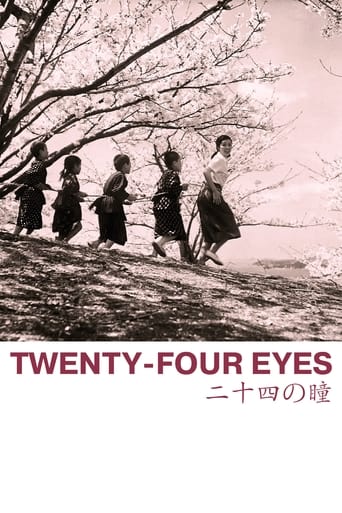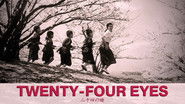lreynaert
One should be very careful when one uses superlatives, but, 'Twenty-Four Eyes' is one of the best movies ever made. Moreover, it is more than ever highly topical, albeit shot in black and white. It is the story of the emotional link between a junior teacher and her class of 12 children.Keisuke Kinoshita's movie tackles directly such crucial issues as freedom of speech (if you speak out against the war, you could lose your job), as calling a spade a spade (a war means simply killing people), as the choice between war and peace, between love and hate, between care (for the children) and selfishness and between sincerity and deceit or worse denouncement. His movie makes one understand that there is an all powerful authority which intervenes behind the scene in people's lives, by manipulating public opinion and by trying to turn the population (and mostly its children and young men) into deaf-mute pawns in order to use them as cannon fodder. Another means is starving the dissidents by firing them. Keisuke Kinoshita's characters are anchored in real life with its poverty (nothing to eat, or no money to go to school), its illnesses (tuberculosis), its accidents and, most importantly, the war and its victims.Keisuke Kinoshita knows what true art is. It is not an expression of emotions, but the creation of emotions (involvement) into the spectator's heart. His movie stands in sharp contrast with the actual avalanche of movie products pieced together with Meccano aliens (concocted with special effects) fighting human killers, while both are shouting their immoral gospel of violence and death. A truly cold world, and in no way the warm atmosphere created by Keisuke Kinoshita's school teacher. 'Twenty-Four Eyes' was shot by a director with a big heart, who made simply an everlasting sublime movie. A must see.
norman-42-843758
Twenty Four Eyes is a story of platonic love and childhood innocence and the maintaining of this love particularly when the innocence is lost to the reality of the world. This love exists between the teacher and her students and also between the students and the teacher. By modern standards it is melodramatic and sentimental in parts and I am sure the traditional Scottish background music played on a violin orchestra would sound as strange to Japanese ears as traditional Japanese music would sound to ours. Most who watch this film will be touched by a time we all long for but know in our hearts we will never see return. Its attraction is the brief opening of a window into this world. There is sadness. Some of the boys are lost in the war and through the circumstances of life many of the girls do not attain the life that they are capable of achieving. Even the teacher's personal life is torn apart by the events of the war. She is even subjected to Japan's own version of McCarthyism but instead of succumbing to anger and sadness she returns to the classroom after a break of many years in order to teach the next generation. Those who are left, gather to show the love and respect that this particular teacher has touched in their hearts. Whilst watching this story unfold I kept asking myself "What happened to Japanese innocence and after offerings such as Severn Samurai and Tenko, did it ever exist? As a story of hope against all the odds it is up there with the Shawshank Redemption and Steven Soderburgh's King of the Hill. This was a very worthwhile film and I am sure it did its part in restoring the Japanese identity after the end of the war.
MartinHafer
"Nijûshi No Hitomi" is an interesting film in that you initially think it's just a heart-warming story about a school teacher but it actually is a tale chronicling the rise of militarism and destruction of a generation. And, in the process, it draws you into the characters' lives and makes you appreciate the great loss--these were decent people.This story begins in a country village in Japan in 1928. A young female teacher is beginning her first assignment and she has trouble with some of the locals not accepting her. They see her as a 'city girl' and despite connecting with the kids, has a hard time being accepted by the parents. The war in China and WWII are still years ahead. The twenty-four eyes in the story refers to the 12 adorable students in her charge--and the film follows them through the 1930s and into the 40s.In many ways, the film is very slow and sweet as their lives unfold, but there is also a strong undercurrent of melancholy for losses that occur throughout the years as well as upcoming losses. This is heightened by the songs chosen throughout the film--all very, very sentimental. Heck, the entire film just drips sentiment. Now this is not a criticism--the film tries from start to finish to pull at your heart.A change slowly occurs through the course of the film. As the Japanese militarism is on the rise, there is also a strong push for the teachers to teach only approved content--content that encourages patriotism and self-sacrifice--turning the children into 'good' little children who want to go off to war. Anyone not espousing this view in the classroom is labeled a 'Red' and the teacher is finding it harder and harder to teach in such an environment. It's also tough because she really can't speak her mind or encourage her male students to lives outside the military. As a result, she decides to quit her job and raise a family of her own. In this, the film really does a good job. Instead of just saying that militarism is evil and destructive, you slowly see the students grow...and then die in a war of aggression. And, you then see the teacher's own kids as they, too, are infected with this view of the world.By the time the movie is complete, Japan has been defeated, the teacher has lost her husband to the war and many of her students from long ago are dead as well. The teacher is just thrilled that all the killing is over and that they can return to normal--something they haven't seen for many years. but, unfortunately, the sad times are not completely behind them. However, now things have come full circle, as the teacher can now finally return back to work--and she has many students who are the children of her original class back in 1928. Later, after class, seeing her wander through the graveyard looking at all the familiar names is quite touching.Overall, this is a very melancholy but beautiful movie. Despite being extremely long and slow, it's not over-long and manages to capture the viewer--pulling them into this sad time. Through very deliberate pacing, exceptional acting and very, very, very sentimental music, the film makes its point so well. When this debuted in Japan, the theaters must have been filled with sobbing patrons.By the way, for another great Japanese film about the waste of WWII, try watching "Fires On The Plain" ("Nobi"). It's very, very different from this film--but exceptional nevertheless.
crossbow0106
For English speaking people, there are not many movies available on DVD starring Hideko Takamine. This is one, and it is a masterpiece. Ms. Takamine plays a schoolteacher in a small Inland Sea village in Japan. The movie's time line is twenty years, from 1928 to 1948. These turbulent times affect the students she teaches, some of whom went off to war. There are many tears in this film, from the children and Takamine's character. The fact that "Auld Lang Syne" is used at times for background music heightens the feelings of loss & sadness, which does make up some of the story. This is somewhat of an anti-war film, but only as it affects the children and the teacher. Ms. Takamine is luminous in this role, as she is in every movie I've ever seen her in. The fact that the director Kinoshita Keisuke also directed her in "Carmen Comes Home" (the first ever Japanese film in color), a film light years away from this one, shows off their versatility in their craft. The only complaint I have is small, that the subtitles are somewhat annoying, since they are sometimes out of sync. However, a great movie is a great movie. This film won the Golden Globe for Best Foreign Language Film. It is a richly deserved honor.


